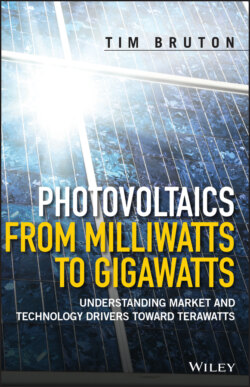Читать книгу Photovoltaics from Milliwatts to Gigawatts - Tim Bruton - Страница 21
1.4 Gallium Arsenide and III–V Alloys for Space
ОглавлениеDespite its many advantages, silicon also has negative characteristics. Namely, it is an indirect bandgap semiconductor and the bandgap at 1.1 eV is not the optimum. This means that a relatively thick absorber layer is required to absorb the solar spectrum, and the bandgap limits the ultimate efficiency that can be achieved. The semiconductor gallium arsenide (GaAs) does not have these disadvantages. As a direct bandgap semiconductor, it requires only a few microns of absorber, which lowers the mass of the solar cell – an important characteristic in space applications. The bandgap at 1.4 eV is very near the optimum for a single‐junction solar cell [44]. GaAs also has the advantage that a wide range of alloys of various group III and V elements exist with different bandgaps and are lattice‐matched to it [62], enabling the high‐efficiency tandem structures envisaged by Jackson [43]. On the other hand, GaAs is a high‐cost technology, with the cost of substrates and active film deposition being much higher than that for silicon. Nonetheless, the cost of the solar cell is a much less important parameter than kWp/kg for space applications [63]. GaAs also has the advantage that it is more radiation‐hard than silicon [64]. GaAs cells have been used in space since the 1960s, with the Russian Venera 2 and 3 missions to Venus. In 1986, 70 m2 of GaAs solar cells were installed on the MIR space station; these functioned for 15 years [65]
The development of III–V cells can be divided into two programmes: single‐junction GaAs cells on either a GaAs substrate or germanium and tandem cells usually on a germanium substrate for use in space but also for concentrating solar cell applications. The bandgaps and lattice constants of the most important III–V compounds are given in Figure 1.12. Silicon solar cells were the preferred space cell technology until the 1990s, when III–V cells began to be used. They remain the dominant technology today.
